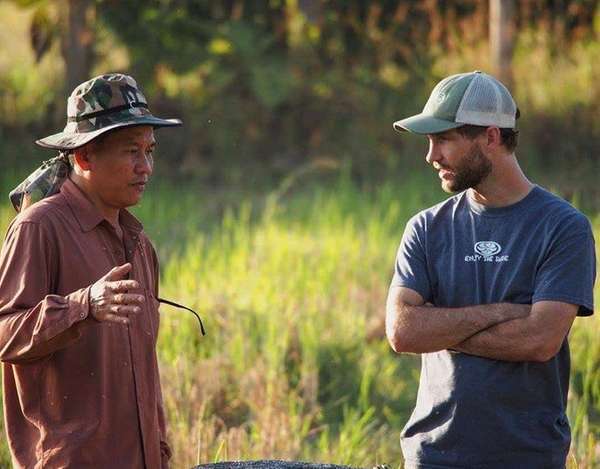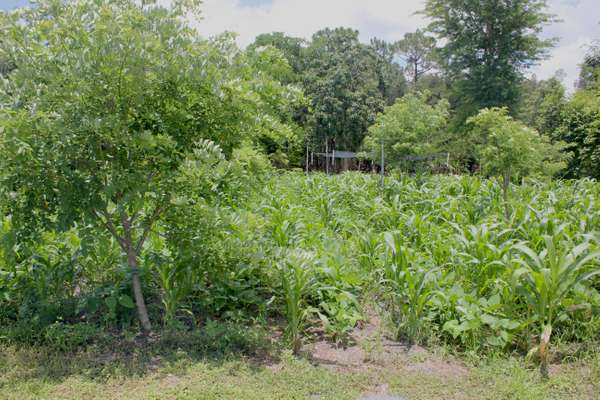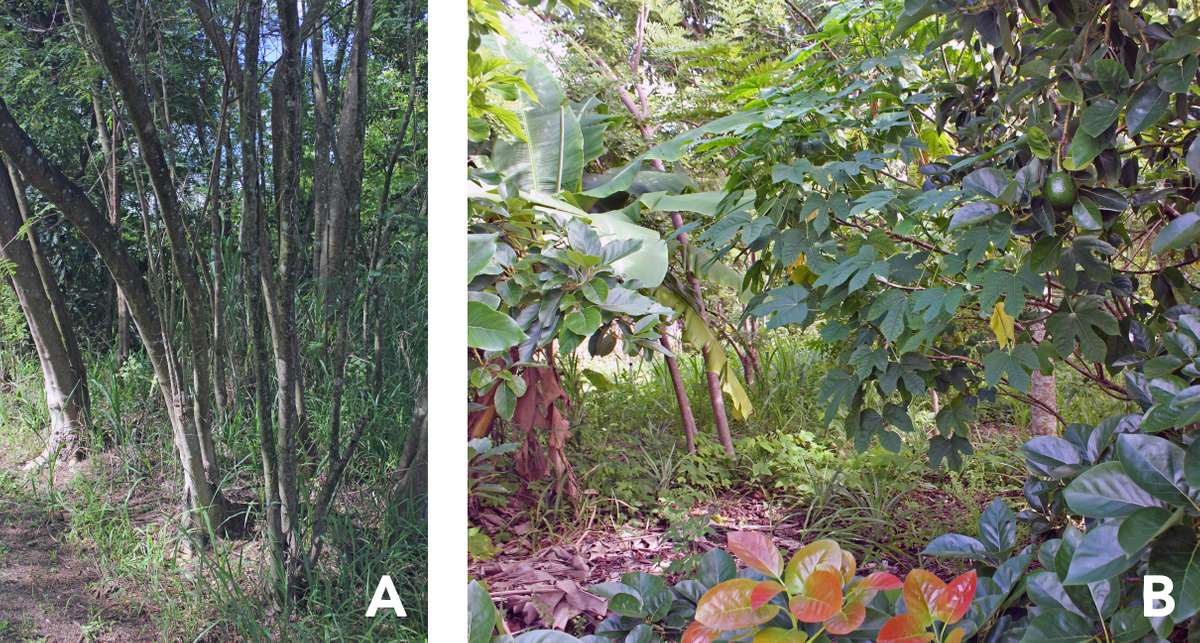
Figure 1. Gathering farmer knowledge, as illustrated here, is essential to involving farmers in climate change mitigation. Source: Patrick Trail
How can smallholder farmers help mitigate against climate change? An article in EDN 148 described principles on which the strategies presented in this follow-up article are based. Key to any agricultural approach for dealing with climate change is dialogue with farmers (Figure 1), whose knowledge, experience, and participation are critical for success. In our conversations, we should distinguish between adaptation and mitigation. Adaptation strategies increase farmers’ resilience and reduce their vulnerability to loss. Mitigation strategies directly reduce the causes of climate change. Some farming practices are helpful both for adaptation and for mitigation. For example, reduced tillage makes a field less vulnerable to erosion (adaptation) while also allowing for more carbon to be stored in the soil (mitigation). Below are a few strategies that are familiar to ECHO and that have mitigation potential in addition to building farmers’ resilience (adaptation) to climate change. Content here builds on an EDN 128 article on carbon farming by Eric Toensmeier (2015).
Annual Cropping Systems
Integrating green manure cover crops (GMCCs) with staple grains

Figure 2. Cowpea (Vigna unguiculata) and gliricidia (Gliricidia sepium) as an annual and perennial legume, respectively, intercropped with maize (Zea mays). Source: Tim Motis
GMCCs cover and improve the soil in farmers’ fields. GMCCs are often legumes, which have a unique ability to improve soil fertility by taking nitrogen from the atmosphere and turning it into a form that can be used by plants. Legumes adapted to the tropics include both annual and perennial species (Figure 2). In the second edition of his book Restoring the Soil, Bunch (2019) documents 117 ways in which smallholders use GMCCs. The book includes a decision-making framework for matching GMCC systems to your local context. Selecting Legumes as Green Manure/Cover Crops (ECHO Staff, 2017) and ECHO’s interactive GMCC Selection Tool may also be helpful for selecting context-appropriate GMCCs. Farmers are most likely to grow GMCCs that provide benefits in addition to soil improvement, such as edible beans, fodder, and/or weed suppression.
1 The percentage of carbon in plants ranges from 46% to 59% (Scharlemann et al., 2014), depending on the crop and plant part (e.g., leaves versus wood). Generally, a value of 50% of dry plant weight is commonly assumed (Gedefaw et al., 2014). Thus, even without knowing the exact carbon concentration as measured in a laboratory, we can multiply dry biomass by 0.5 to estimate carbon in plant material.
The amount of carbon sequestered in soils by GMCCs depends, in large part, on how much plant material is grown and left on the soil. You can calculate approximately how much carbon is in that biomass by collecting and drying leaves, stems, and roots from a small plot of known dimensions, such as 1 square meter. Ideally, drying will be done in a cabinet with air heated to about 60°C and circulated with fans; however, air-drying in the sun is sufficient for a rough calculation. Weigh the plant material every day or two until the dry weight is reached—the point at which there is no more weight loss. (Cover the biomass or bring it indoors, as needed, to keep it from getting rained on.) Multiply the dry weight by 0.5 1 to estimate the mass of carbon in the 1 m2 of biomass. One ha is 10,000 m², so multiply the result by 10,000 to calculate the mass of carbon per ha. For greater accuracy, repeat these steps in three or four places in a field, and average the results.
Fujisaki et al. (2018) found that up to 36% of carbon inputs were converted to soil organic carbon. Despite the fact that not all carbon in plants transfers to the soil (some moves back into the atmosphere, as explained in Part 1), GMCCs can still increase the amount of carbon stored in soils. On a sandy-loam soil in Benin, a system involving maize and velvet bean (Mucuna pruriens) added 1.3 metric tons of soil carbon per ha each year to the top 40 cm of soil (Barthès et al., 2004).
Conservation agriculture
Conservation agriculture includes three main elements: constant soil cover, minimum soil disturbance, and crop diversity (ECHO Staff, 2016). Mulch protects soil from erosion, preserving soil carbon. Mulch itself consists of living or dead plant material, so it adds organic carbon to the soil. Zero or reduced tillage is necessary to maintain surface mulch. Reduced tillage methods that preserve surface mulch include planting seeds in holes dug with sharpened sticks or hoes, or planting in narrow furrows created with rippers.
Most small-scale farmers find it difficult to maintain soil cover with staple crop residues alone. Crop residues may be needed for livestock feed or as kindling for cooking fires. The emphasis on crop diversity within conservation agriculture can result in a source of vegetation for mulching, for example through crop rotation and intercropping. Look for crops that maximize carbon inputs above and below the soil. Legumes such as lablab (Lablab purpureus) and pigeon pea (Cajanus cajan) produce an abundance of above-ground biomass, and their deep roots deposit carbon into the soil. At the same time, they add nitrogen to the soil, which supports crop biomass production.
Soil carbon storage with conservation agriculture depends on how well the crops grow and, in turn, how much biomass they return to the soil. Studies in Brazil have shown that a combination of vegetative cover and no-till added 0.4 to 1.7 metric tons of carbon per year to the top 40 cm of soil (Bernoux et al., 2006). Gains in soil carbon are most likely to occur when crop selection and farming practices take into account local growing conditions and farmers’ needs and constraints. Look for efficient ways to meet crop requirements for fertility and water. Select tillage and seeding practices based on tools that can be made and maintained locally, and that are not unnecessarily laborious. Select intercrops or rotational crops based on what seed is readily available.
System of Rice Intensification (SRI)

Figure 3. Flooded rice production. Source: Stacy Swartz
Rice is a major staple, often grown in flooded paddies (Figure 3). The water in rice paddies replaces oxygen in the soil, creating anaerobic (lacking oxygen) conditions. Microbes that produce methane (CH4) thrive in such an environment, which is why rice cultivation accounts for at least 10% of agricultural greenhouse gas (GHG) emissions (Project Drawdown, 2020). The SRI method calls for intermittent watering instead of flooding (Berkelaar et al., 2015), which means less CH4 is produced. In Malaysia, CH4 emissions were nearly three times less with SRI methods than with conventional flooding (Fazli and Man, 2014). The SRI method also includes organic fertility inputs, which add carbon to the soil. According to Project Drawdown (2020), 4 to 5 million farmers practice SRI, and SRI has the potential to sequester significant amounts of carbon (2.79 to 4.26 billion metric tons of CO2 equivalents between 2020 and 2050).
Tree-based farming
Agroforestry combines trees and agriculture. Trees and shrubs reduce GHG by storing carbon in their living tissues, in wood products, and in the soil. When considering whether or not to promote trees in an area, take note of the native vegetation. Do trees naturally grow there? If not, it is probably not wise to plant trees there. Plants found in open savannas and grasslands effectively store carbon below-ground, and they generally do so with less water and nutrients than trees (Veldman et al., 2015). Where it does make sense to plant trees, consider tree survival rates in addition to the number of trees planted. Trees that provide needed resources for farmers, and that are integrated into their cropping systems, are much more likely to survive than randomly-planted trees. Below are several practical ways in which small-scale farmers practice agroforestry.
Farmer Managed Natural Regeneration (FMNR)
FMNR is a reforestation approach in which farmers manage regrowth of an “underground forest” consisting of stumps of trees that were previously cleared for growing crops (Rinaudo, 2010). Farmers select which stumps to manage and decide how many stems they will allow to regrow on each stump. They know which trees will benefit their crops and which will compete with them. The trees benefit the soil by dropping their leaves (mulch) and by reducing soil temperature, water evaporation, and erosion. They also store carbon; between 2006 and 2018, FMNR on 2,700 ha of land in Ethiopia sequestered 181,650 metric tons of CO2 (World Vision, 2019). Community residents reported numerous benefits that included less soil erosion, improved soil fertility, increased rainfall, and better air quality.
Family woodlots
Caretakers and beneficiaries are not always clearly identified in large-scale tree planting projects. This is not a problem with small family woodlots devoted to household use (Figure 4A). As explained by Azor and Blank (2010), a woodlot consists of coppicing tree species such as Senna siamea and Leucaena spp. A tree that coppices well will produce new shoots after being cut very low on the main stem (trunk). Coppicing allows for multiple harvests from a single tree over time. Trees sequester the most carbon when they are actively growing; this means the regrowth that occurs after coppicing will store significant amounts of carbon. Small woodlots have proven successful in Haiti, where the Mennonite Central Committee promoted them through an effort called “ti fore” (Creole for “little forest” or microforest).

Figure 4. Woodlot (A) and food forest (B) demonstrations at ECHO’s Global Farm in Florida. Source: Tim Motis
Tree gardens and food forests
Tree gardens consist of fruit trees and other beneficial trees grown together with annual crops (Danforth and Noren, 2011). Farmers protect the trees, along with their crops, from animal grazing and fire. This concept has worked well in Central Africa. Food forests (Figure 4B) are popular in Southeast Asia, where mixtures of edible tree species are grown together in small plots. Tree gardens and food forests work well in small-scale agriculture systems. For more information, see the “Fully Perennial Systems” section of Toensmeier’s 2015 carbon farming article in EDN 128.
Land-care approaches
Sloping Agricultural Land Technology (SALT)
SALT, an approach that integrates aspects of soil conservation and agroforestry, was developed to reduce soil erosion on hillsides (MBRLC, 2012). Field crops are grown in 3- to 5-m wide bands between double rows of leguminous trees and shrubs that are planted along contour lines. The nitrogen-fixing trees and shrubs are managed as hedgerows, with pruned vegetation used as mulch for the crops between hedgerows. Farmers modify the system based on the types of crops and trees they want to grow. In a five-year study in India, on land with 2 to 5% slope, gliricidia hedgerows in combination with grass strips reduced soil loss by 35% and added 1.35 t/ha/year of organic carbon to the soil 1 m away from the hedgerows (Lenka et al., 2012). Though that system is not quite the same as SALT, their findings document the potential of contoured hedgerows to conserve soil and store carbon.
Sand dams for restoring watersheds
Stern and Stern (2011) describe a sand dam as “a reinforced concrete wall built across a seasonal river to hold underground water in sand.” Sand dams are an excellent option for harvesting rainwater in dryland regions. Water stored in the sand provides drinking water. Sand dams also increase groundwater, especially when multiple dams are constructed within a watershed. Based on satellite imagery, Ryan and Elsner (2016) found that sand dams consistently increased vegetation. They concluded, “Sand dams can…be a promising adaptation response to the impacts of future climate change on drylands.” Sand dam initiatives can be accompanied by agricultural activities that sequester carbon (Maddrell, 2018). Contour-based plantings, for instance, reduce erosion on either side of a dam and have the potential to increase soil carbon. Indigenous groups in Kenya and elsewhere have done extensive work in promoting and constructing sand dams.
Concluding thoughts
Farmers are well-positioned to implement site-specific solutions to climate change. Here we have highlighted a few cropping systems that farmers can and/or are using to produce food in ways that reduce GHG. No single system or strategy works for--or is acceptable to--every farmer. Work with farmers to identify approaches that address climate change while also meeting their needs. An article titled Farmer Engagement in Agriculture Extension suggests practical ways to support farmers’ efforts to develop and test agricultural improvements (Flanagan, 2015). Those ideas are also relevant in engaging with farmers to identify strategies for dealing with climate change.
References
Azor, J.R. and D. Blank. 2010. Coppicing woodlots. ECHO Development Notes 107:5-6.
Barthès, B., A. Azontonde, E. Blanchart, C. Girardin, C. Villenave, S. Lesaint, R. Oliver, and C. Feller. 2004. Effect of a legume cover crop (Mucuna pruriens var. utilis) on soil carbon in an ultisol under maize cultivation in southern Benin. Soil Use and Management 20:231-239.
Berkelaar, D., B. Thansrithong, R. Haden, R. Uprety, and R. Burnette. 2015. SRI, the System of Rice Intensification. ECHO Technical Note no. 82.
Bernoux, M., C.C. Cerri, C.E.P. Cerri, M.S. Neto, A. Metay, A-S. Perrin, E. Scopel, T. Razafimbelo, D. Blavet, M. de C. Piccolo, M. Pavei, and E. Milne. 2006. Cropping systems, carbon sequestration and erosion in Brazil, a review. Agronomy for Sustainable Development 26(1):1-8.
Bunch, R. 2019. Restoring the soil: How to use green manure/cover crops to fertilize the soil and overcome droughts. ECHO Inc.
Danforth, R. and P. Noren. 2011. Tree gardening. ECHO Technical Note no. 69.
ECHO Staff. 2016. Conservation agriculture. ECHO Best Practice Note no. 6.
ECHO Staff. 2017. Selecting legumes as green manure/cover crops. ECHO Best Practice Note no. 7.
Fazli, P., and H.C. Man. 2014. Comparison of methane emission from conventional and modified paddy cultivation in Malaysia. Agriculture and Agricultural Science Procedia 2:272-279.
Flanagan, B. 2015. Farmer engagement in agriculture extension. ECHO Development Notes 128:4-5.
Fujisaki, K., T. Chevallier, L. Chapuis-Lardy, A. Albrecht, T. Razafimbelo, D. Masse, Y.B. Ndour, and J. Chotte. 2018. Soil carbon stock changes in tropical croplands are mainly driven by carbon inputs: A synthesis. Agriculture, Ecosystems and Environment 259:147-158.
Gedefaw, M., T. Soromessa, and S. Belliethathan. 2014. Forest carbon stocks in woody plants of Tara Gedam Forest: Implication for climate change mitigation. Science, Technology and Arts Research Journal 3(1):101-107.
Lenka, N.K., A. Dass, S. Sudhishri, and U.S. Patnaik. 2012. Soil carbon sequestration and erosion control potential of hedgerows and grass filter strips in sloping agricultural lands of eastern India. Agriculture, Ecosystems and Environment 158:31-40.
Maddrell, S.R. 2018. Sand dams: A practical & technical manual. Excellent Development.
[MBRLC] Mindanao Baptist Rural Life Center. 2012. ECHO Technical Note no. 72.
Project Drawdown. 2020. http://drawdown.org. Accessed 14 July 2020. [NOTE: This website gives detailed information on numerous practical ways to reduce atmospheric carbon.]
Rinaudo, T. 2010. Farmer Managed Natural Regeneration. ECHO Technical Note no. 65.
Ryan, C. and P. Elsner. 2016. The potential for sand dams to increase the adaptive capacity of East African drylands to climate change. Regional Environmental Change 16:2087-2096.
Scharlemann, J.P.W., E.V.J. Tanner, R. Hiederer, and V. Kapos. 2014. Global soil carbon: Understanding and managing the largest terrestrial pool. Carbon Management 5(1):81-91.
Stern, J.H. and A. Stern. 2011. Water harvesting through sand dams. ECHO Technical Note no. 70.
Toensmeier, E. 2015. Carbon farming: building soils and stabilizing the climate. ECHO Development Notes 128:1-3.
Veldman, J.W., G.E. Overbeck, D. Negreiros, G. Mahy, S. Le Stradic, G. W. Fernandes, G. Durigan, E. Buisson, F.E. Putz, and W.J. Bond. 2015. Where tree planting and forest expansion are bad for biodiversity and ecosystem services. BioScience 65:1011-1018.
World Vision. 2019. Farmer Managed Natural Regeneration: A holistic approach to sustainable development. https://www.wvi.org/sites/default/files/2019-12/FMNR%20Publication%203Dec_Online_0.pdf Accessed 23 June 2020.
Cite as:
Motis, T. 2020. Farmer-Centered Climate Change Mitigation. ECHO Development Notes no. 149